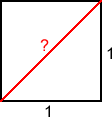Or search by topic
Number and algebra
Geometry and measure
Probability and statistics
Working mathematically
Advanced mathematics
For younger learners
Published 2004 Revised 2009
The Dangerous Ratio

It's a stormy day on the sea off the coast of Greece. The date is around 520 BC. Fighting for his life, a man is heaved over the side of a boat and dropped into the open water to die. His name is Hippasus of Metapontum. His crime? Telling the world a mathematical secret. The secret of the dangerous ratio.
The murder of Hippasus is a matter of legend, but the secret was real, and certainly dangerous enough to the beliefs of those who knew about it.
It was a secret owned by the school of Pythagoras. These early Greek mathematicians (Pythagoras himself was born around 569 BC ) were obsessed with the significance of whole numbers and their ratios. The Pythagorean's motto, carved above the entrance of the school, was "All is number".
The inner circle of the school, the mathematikoi, believed that the universe was built around the whole numbers. Each number from one to ten was given a very special significance. Odd numbers were thought to be male and even numbers female. Yet there was one number that the Pythagoreans found terrifying, the number that might have cost Hippasus his life for revealing its existence to the world.
The name Pythagoras these days is best remembered for a geometrical theorem, the one that tells us how to calculate the lengths of the sides of a right angled triangle, and it is from this theorem that the dangerous ratio emerges.
Imagine a simple square shape, each side 1 unit in length. How long is the square's diagonal?

You may also like
What Are Numbers?
Ranging from kindergarten mathematics to the fringe of research this informal article paints the big picture of number in a non technical way suitable for primary teachers and older students.

